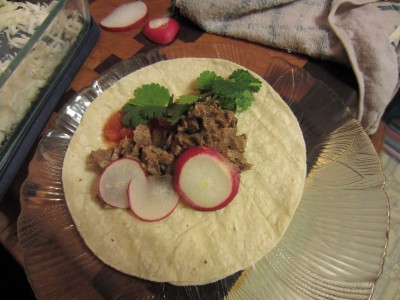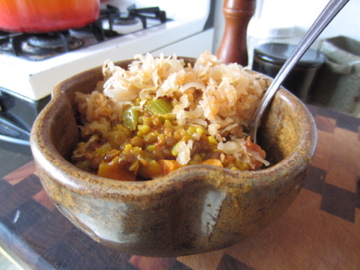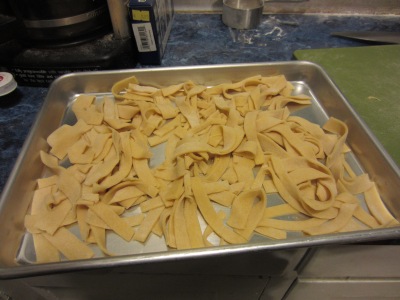Growing up, we basically had two cookbooks in the house – The Joy of Cooking and The Male Chauvinist’s Cookbook (sadly without that hilarious cover). The Joy of Cooking covered almost all of my early cooking experience, backed up by the array of recipes in my mom’s recipe box (including “Alice B. Toklas Brownies”, which had an interesting herbal component), so it only made sense that I should get a copy of it when I got my own place.
In 1997, when I got my first apartment, they had just rereleased Joy of Cooking, so that’s the version I have. Sadly, it’s the first edition to omit the directions and hilarious illustration for skinning a squirrel – I suppose the Rombauer family didn’t foresee the resurgence of “Chicken of the Trees” in foodie circles. A shame, that. I’m on the lookout for a squirrel hunting experience, by the way – hit me up if you’re in the Twin Cities area and are open to someone tagging along.
Anyhow. One of the first recipes I remember making after getting this is the butterscotch pudding, on page 1019. My book automatically opens to that page now:

Clearly a well-loved book.
It’s a super simple recipe. I honestly have no idea what inspired me to make it for the first time, since butterscotch is kind of a “meh” thing for me, but I’m glad I did – it’s the source of one of my favorite stories. Chris and I had just been married for a few months at that point and we had a friend who frequently came to hang out. One night I pulled a batch of this butterscotch pudding out of the fridge and our friend dug in, ate the whole serving in a few bites, and asked me to marry him. We all got a good laugh out of that. Ever since, I make this recipe from time to time because it makes me laugh. And also because it’s really *really* good.
It’s a very straightforward recipe, which is nice. You melt butter and mix in dark brown sugar, then cook it for a few minutes until it’s bubbly. Add cream to dissolve the caramel, then milk and a pinch of salt. Thicken with a cornstarch slurry, then stir in vanilla and chill.

Ingredients, minus the horribly unphotogenic cornstarch slurry.
That’s a little bit of molasses on top of the brown sugar, since I ran out of dark brown sugar and wasn’t about to run to the store just for that. Turns out I was also out of milk, but half and half made a passable substitution. And now I have to go to the store for real, because if there’s no half and half in the house tomorrow morning, things will be fairly ugly.

Butterscotch! You’ll want yours a fair bit darker than this. I should have caramelized this more, in retrospect.
If you, like me, run out of dark brown sugar and substitute light brown sugar, make sure you caramelize it a bit more than this. I was distracted and following directions instead of observing – your eyes, ears, mouth, and sense of smell are as important in cooking as the actual recipe.
Once you’ve added in the dairy products, you’ll want to slowly whisk about 1/4 of the caramel sauce into your cornstarch slurry. This slowly raises the temperature of the starch so it doesn’t seize up when you add it to the pot. Once you’ve tempered the cornstarch (what you just did!), whisk it back into the pot and cook over low heat until it thickens. Make sure you whisk/stir this constantly to avoid burning and uneven thickening.
Here’s where I confess that I screwed up – Joy tells you to let the caramel sauce cool before adding the cornstarch slurry directly to the pot. I’ve always modified this to save a little time and done what I discussed in the previous paragraph. My brain’s somewhere else today, and I remembered the part about not waiting for the caramel to cool before thickening it, but not the part about tempering it into the cornstarch. Therefore, I whisked the cornstarch slurry directly into the boiling caramel sauce. As you might imagine, I ended up with a somewhat curdled pudding. In an effort to salvage it, I passed it through a sieve before stirring in the vanilla. It worked, mostly. The texture is nowhere near as creamy smooth as usual, and combined with my failure to cook the caramel long enough I’ve got a tasty but not mind-blowing end product. With enough whipped cream it’ll be fantastic, though.

Lumpy texture in evidence
Cover this with plastic wrap, laying the wrap directly on the surface of the pudding (unless you’re someone who likes their pudding with a skin on top, which I’ve heard is a thing). Refrigerate for several hours before digging it.
Butterscotch Pudding, adapted from Joy of Cooking
- 3TB unsalted butter
- 1/2 cup dark brown sugar, packed
- 1/2 cup heavy cream
- 1 1/2 cups whole milk
- 1/4 tsp salt
- 3 TB cornstarch
- 3 TB water
- 1 tsp vanilla extract
In a heavy pot, melt butter. Stir in brown sugar and cook until dark brown and bubbly, stirring frequently. Reduce heat and stir in heavy cream, stirring until the butterscotch is dissolved. Stir in milk and salt and remove pan from heat. In a heatproof bowl, stir cornstarch and water together. Slowly whisk in about 1/4 of the milk/butterscotch mixture, then whisk back into the pot. Over medium heat, cook pudding until it boils and thickens, stirring constantly to prevent sticking. Remove from heat and stir in vanilla, then divide pudding between four custard cups, covering with plastic wrap placed directly on the surface of the pudding. Refrigerate for 2-4 hours before eating. Serve with whipped cream.

























